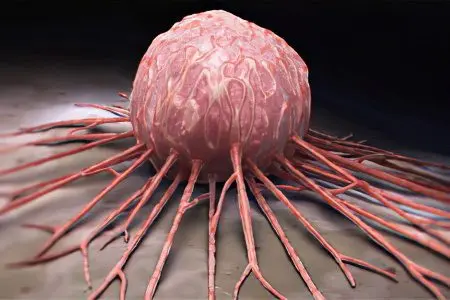Contents
- Why does atheroma occur?
- Symptoms of atheroma
- Visual signs of atheroma
- Differentiation of atheroma from similar pathologies
- Atheroma inflammation
- Diagnosing
- Surgical treatment of atheroma
- The difference between surgical intervention in a complicated form
- Postoperative period
- Dangerous signs of complications after surgery
- Answers to Frequently Asked Questions
This pathology does not apply to tumors, although the suffix “-oma” (lipoma, hemangioma, myoma), at first glance, assigns it a place in the class of neoplasms. In fact, atheroma is a cyst of the sebaceous glands, which was formed not due to inflammation, but for completely different reasons.
The most common localization of atheroma on the human body is areas of active production of sebum, characterized by a greasy sheen. This is the face, the area behind the ears, on the back of the head, between the shoulder blades, on the coccyx.
Why does atheroma occur?

The basis of the appearance of a cyst is a blockage of the outlet duct of the sebaceous glands. As a result, the sebum produced by the gland does not come to the surface, but accumulates inside. The duct increases in size, and the body’s defense system, trying to stop this process, forms a cyst from the connective tissue in the form of a cavity around the atypical formation.
Factors leading to blockage of the sebaceous glands:
Trauma of the epidermis – skin cells after damage to it with a blunt object clog the lumen of the duct of the sebaceous gland.
Low level of personal hygiene – dust particles, other contaminants must be regularly removed from the surface of the skin so as not to clog the excretory ducts of the glands.
Hormonal imbalance, the predominance of male hormones – testosterone, dehydroepiandrosterone – leads to a change in the functioning of the sebaceous glands, increased secretion of sebum and its thickening.
Postmenopause – during menopause in the female body, the concentration of estrogens sharply decreases, which increases the likelihood of changes in the composition of sebum and the formation of atheroma.
Although most often atheroma occurs in adults, the congenital form of this neoplasm is occasionally diagnosed in children. The cyst is formed in front of the auricle and looks like a small ball up to 2 cm in diameter. The cause of atheroma in children is a small defect in the epidermis in the auricle. In the future, such atheroma does not develop and does not affect the health of the child.
Symptoms of atheroma

Since the formation of atheroma is not accompanied by an inflammatory process, there are no symptoms such as weakness, fever, loss of appetite, hyperemia, and changes in the surface layer of the skin. If the atheroma does not become inflamed, then no problems other than a cosmetic defect are fixed.
Location of the cyst:
Back – more often occurs on the skin between the shoulder blades, although another part of this part of the body is not excluded;
Head – face, back of the head, area around the ears, chin;
Crotch;
Coccyx;
Armpits;
Popliteal pits.
In those areas of the human body in which there are no sebaceous glands (palms, feet), atheromas never form.
Visual signs of atheroma
This is a round formation located deep under the skin. Even a small atheroma is visible to the naked eye, has a diameter of 0,5 cm, reaching in rare cases a value of 20 cm. Since the cyst is constantly growing, its size increases over time. This formation is painless even on palpation, has a denser consistency than nearby tissues. When trying to move the cyst to the side, it easily gives in to the applied efforts.
Differentiation of atheroma from similar pathologies
A sebaceous cyst in its symptoms may be similar to other subcutaneous formations – an enlarged lymph node, fibroma or lipoma. It is important to know their characteristic features in order to distinguish them from each other. Other formations are so rare that their symptoms do not matter for diagnosis.
Sign | Atheroma | Lipoma | Fibroma | lymph node |
Mobility of the skin layer over the formation | Inseparable from the skin, as it is formed in the thickness of its layer | Located under the layer of skin, so the skin is mobile | ||
Appearance | Looks like a rounded formation that rises above the skin | Often not visible without the use of special equipment, without magnification | ||
Density | The consistency is soft | Thick consistency | ||
Morbidity | Usually painless, with suppuration, tenderness appears on palpation | Formations are painless | Painful | |
The main features make it possible to differentiate atheroma from similar pathologies.
Atheroma inflammation
When pathogenic microorganisms enter the cyst cavity, its tissues can become inflamed. The cause of inflammation is trauma to the epidermis as a result of cuts, piercing the skin, scraping off the upper layer, attempts to squeeze out atheroma on the face, neck, and back of the head.
Signs of inflammation:
An increase in atheroma in size by several centimeters in the shortest possible time;
Hyperemia;
puffiness;
Pain on palpation of atheroma.
As a result of inflammation and tissue melting, pus finds a way out, breaking through the skin. After applying a sterile dressing, you need to contact the surgeon to remove the remnants of the connective tissue of the capsule and sanitize the wound.
If you do not consult a doctor and self-medicate, the remaining parts of the capsule will cause the re-formation of atheroma.
Diagnosing
A standard study is an ultrasound, when analyzing the results of which you can see the capsule. The cavity is a characteristic sign of atheroma. Laboratory studies, other diagnostic methods are not informative.
Surgical treatment of atheroma
The only effective way to treat atheroma is surgical removal, because drug therapy or traditional medicine recipes do not bring any significant result and can cause a relapse.
As soon as signs of inflammation appear around the formation, you should immediately contact the outpatient clinic or the emergency room of a surgical hospital. Uncomplicated atheroma is operated on in a planned manner.
The main goal of surgery is the removal or destruction of the cyst and its contents. Methods of surgical treatment:
Method | Method content | Advantages |
Classic method | An incision is made in the superficial layers of the skin, through which the cyst is removed without violating its integrity. A suture is applied to the wound and then the threads are removed in dressing after healing |
|
Argon-plasma coagulation | Atheroma is destroyed with a plasma beam at the end of a special scalpel, simultaneously with tissue destruction, blood stops |
|
Laser destruction | Laser knife destroys the cyst and its capsule |
the disadvantage of these methods is their low prevalence due to the high cost of equipment and its absence in public clinics |
Electrocoagulation | Electroknife removes a cyst with high frequency current | |
radio wave knife | Atheroma tissues are burned out using high-intensity radio waves |
All methods of surgical intervention require the introduction of local anesthesia. The operation to remove atheroma rarely lasts more than 20 minutes.
The difference between surgical intervention in a complicated form
After removing the festering atheroma in any way, the wound is not sutured tightly, but a hole is left in it for drainage. Its role is played by a rubber tube treated in an antiseptic solution. Then a sterile dressing is applied to the wound field. Wound suturing tightly occurs in the treatment of uncomplicated atheroma.
Postoperative period
In the first days after removing the capsule, it is important to carefully monitor the condition of the wound. At first, the surgeon performs daily procedures, changing the drainage device and antiseptic dressings. The total duration of the postoperative period is 10-14 days. It takes place on an outpatient basis. Occasionally, complicated forms of atheroma are treated in a surgical hospital.
After the formation of connective tissue between the edges of the wound, the sutures are removed. This manipulation takes no more than 3-5 minutes, usually it is painless.
Dangerous signs of complications after surgery

Accession of inflammation after removal of an uncomplicated form of a cyst, the appearance of pus;
An increase in temperature indicates tissue infection, normally hyperthermia disappears for 2-3 days;
The divergence of the edges of the wound – is detected during dressing;
Blood leakage through the bandage – increased bleeding is diagnosed with hepatitis, hemophilia, thrombocytopenia, enlarged spleen, as well as in patients using anticoagulants (Aspirin, Cardiomagnyl, Heparin, Thromboass).
The appearance of any of the above symptoms is a reason to consult a doctor who will assess the risk of complications and take therapeutic measures.
Answers to Frequently Asked Questions

Is there a risk of recurrence of atheroma? Yes, even a small amount of preserved cells can give rise to a new cyst.
What does a postoperative scar look like? Can it be avoided? Minimal scars are formed after surgery using radio waves. In second place is the argon-plasma method. After these interventions, there may be no scars at all. Traditional surgery leaves noticeable scars.
How to prevent atheroma? There are no specific methods of prevention. It is important to control the hormonal background, observe hygiene, and avoid skin injury.
What is the difference between atheroma and lipoma? Lipoma is located in the thickness of adipose tissue, it is caused by excessive growth of connective tissue and is a benign tumor.
Can the process become malignant? No, such cases are excluded, this is not a precancerous disease.
Can self-destruction of the cyst occur? No, this is impossible, atheroma cannot dissolve, it remains unchanged for a long time.
Is a surgeon obligated to operate on non-inflamed atheroma? Services under the MHI policy may not provide for the removal of non-inflamed atheroma. The way out is to be operated on in a private clinic or wait for the development of inflammation, which does not guarantee the absence of a cosmetic defect after the intervention.
What are the consequences of self-extrusion of atheroma? The cyst is usually located in places of intense blood circulation, so there is a high risk of infection spreading to the brain through the blood vessels if bacteria enter the wound. It is impossible to squeeze out a cyst – you need to seek qualified medical help.










Salom 2 yosh qizimni apiratseya qildirdim xafli emasmi